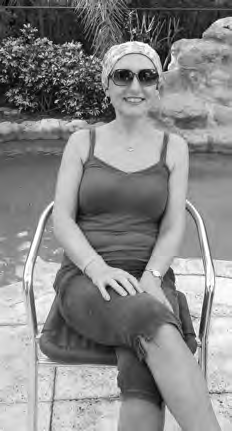100 Perks of Having Cancer: Plus 100 Health Tips for Surviving It (41 page)
Read 100 Perks of Having Cancer: Plus 100 Health Tips for Surviving It Online
Authors: Florence Strang
Tags: #Health; Fitness & Dieting, #Diseases & Physical Ailments, #Internal Medicine, #Oncology, #Cancer, #Medicine & Health Sciences, #Clinical, #Medical Books, #Alternative Medicine, #Medicine

should be respected, regardless if they’re plant-based or not. Don’t be a food
meanie.
Occasionally, I like a good tuna salad sandwich. And until recently, I have
just been “doing without” because of my plant-based eating style. However,
even before I started limiting seafood in my diet, I tried to
avoid large fish like tuna because of their high level of con-
Exciting new recipes
taminates. Larger fish, because of the amount of food they
don’t have to be
consume and their size, have higher levels of mercury in their
“substitutions” for old
flesh. When you eat the contaminated fish, the mercury, in
favorites. They can just
the form of methylmercury, accumulates in your body and
be exciting new recipes.
can cause neurological damage over time. Fetal risks are
greater. Your size determines the amount of mercury that is
considered safe for you to consume. For example, according to the Environ-
mental Protection Agency (EPA), a child weighing twenty pounds should only
eat a sandwich made with white albacore tuna every ten weeks! Someone
weighing one hundred and twenty pounds should wait eleven days before
eating tuna again. Knowing that just reinforces my decision to eliminate tuna
from my food choices, but I still liked the way it tasted.
So How Do You Get the “Tuna” Without the “Fish”?
Here’s the beauty of plants: There are tastes and textures
to match anything in the animal world. In this case, seeds
and chickpeas are used to get the texture and color, and
flavorings are added for taste. When I found this recipe,
I was skeptical, but after tasting it, and after seeing my
husband (an anti-vegite) find the bowl of this in the
fridge and devour it, I became a believer. I make this all
the time because it’s so easy. It’s great as a dip, too.
Recipe and photo by Trish Cowper. For more great recipes like this, go to:
www.infinebalance.com.
Perk #42: Packing Light
167
CHICKPEA OF THE SEA
YIELD: ABOUT 2 CUPS
1 cup cooked (or canned, but cooked is healthier) chickpeas, rinsed and drained
1/2 cup raw unroasted sunflower seeds
1/4 cup sesame seeds
1 tablespoon soy sauce
2 tablespoons lemon juice
2 teaspoons olive oil
A pinch or two of sea salt
1 to 2 stalks celery, finely diced
1/4 cup finely diced red onion, or less
1/4 to 1/2 cup Vegenaise or any vegan mayo
A good pinch of fresh black pepper
If you’re cooking your chickpeas to avoid the BPA in canned, cook this way:
Place 1 cup of chickpeas in a bowl and add enough water to cover them. Let
soak overnight. Drain, rinse, and transfer to a pot with a lid. Cover with water
that is twice the amount of the chickpeas and bring to a boil. Cover, reduce
heat, and simmer for 1 hour. Remove from heat and drain (This can be done
up to 3 days in advance and kept in the fridge.)
In a blender or food processor, add chickpeas, seeds, soy sauce, lemon juice,
olive oil, and sea salt. Add a tablespoon or two of water if you need to get the
mixture to move a bit, but only if necessary. Blend until relatively smooth,
but not pasty. It should have some texture to it. Transfer to a small mixing
bowl and add celery, onion, mayo, and black pepper. Let it sit in the refriger-
ator at least 30 minutes or overnight. (This step is vital.) Makes enough filling
for about 4 hearty sandwiches. Great with celery sticks and on salads, too.
NUTRITION IN 1/4 OF THE MIX:
Calories: 319; Fat: 23 grams; Protein: 10grams; Fiber: 5.5 grams; Iron: 19%
of the RDA; Calcium: 12.8% of the RDA; Vitamin C: 8.5% of the RDA.






Perk #43
A Free Trip to Florida
I
was on a real high after surviving chemo and finally start-
ing to feel like my old self again by Christmastime. I
thought,
Life doesn’t get any better than this.
Ah, but I was
so wrong . . . life did get better! When I opened my Christ-
mas gift from my sister, Lynette, and her generous husband,
Jeff, I was surprised to find plane tickets to Florida! (To be
accompanied by my boyfriend Shawn and my parents.)
The surprise vacation could not have come at a better
time. It allowed me to recoup after my chemo treatments
and prepared me both men-
tally and physically for my
There is nothing like a
upcoming mastectomy. While
good dose of sunshine to
my colleagues in Canada were
lift your spirits when you
trudging to work through sev-
are undergoing cancer
eral feet of snow, I was loung-
treatments. If you are
ing by the pool, soaking up the
not able to fly off to a
rays, with a warm breeze blowing through my
tropical destination, just
stubble. Without a doubt, that was one of the
get outside and enjoy
nicest perks of having cancer!
the sunshine.
HEALTH TIP #43
Take a Vacation in Your Own Backyard
C
ontrary to what we might think, our natural habitat is not on a couch
or in a cubicle. It’s outdoors among the trees, grass, and fresh air. We
keep forgetting that we belong to the “wild kingdom” and we are pro-
grammed by deep-seated, million-year-old genetics before anything else to
realize that nature is our true home. You don’t have to go farther than your
own backyard to enjoy the benefits of green space, fresh air, and sunshine!
I 168 J
Perk #43: A Free Trip to Florida
169
In line with this thought, recent studies show that humans are healthier when
they have access to parks and green spaces. The connection between nature and
health, both physical and mental, has been studied for years. Researchers at the
University of Illinois are compiling fact-based evidence that shows we experience
a “feeling” of well-being when we are exposed to the outdoors, but we also
experience better blood sugar control, and we have an increased
immune response, which can be translated into a reduction of can-
Exposure to the
cer risk. They also found that simple exposures to green landscapes
green spaces of the
were associated with shorter recovery times from surgery.
outdoors benefits
On the flip side, those with no access to green spaces had
your body, mind,
a higher risk of obesity, cardiovascular disease, and death. The
and spirit—and best
data results were independent of the person’s amount of exer-
of all, it’s free!
cise and socioeconomic status.
Scientists relate these human studies to what they see in
the animal world. Animals taken out of their natural habitat and placed in
concrete ones have higher rates of sickness and death, reproduction prob-
lems, and an odd phenomena called “soiling the nest,” where animals
destroy their man-made homes because of an inability to cope.
The same holds true for us. Comparisons were made of residences in
urban areas. The neighborhoods with direct access to grass and trees had a
lower rate of crime and vandalism regardless of socioeconomic status. Those
living in these green areas also had more job satisfaction, better moods, less
violence and aggression, and showed better impulse control when they had
access to some form of nature, even if it was just a visual one.
Worldwide studies confirm this. In the Netherlands, for example, it is found
